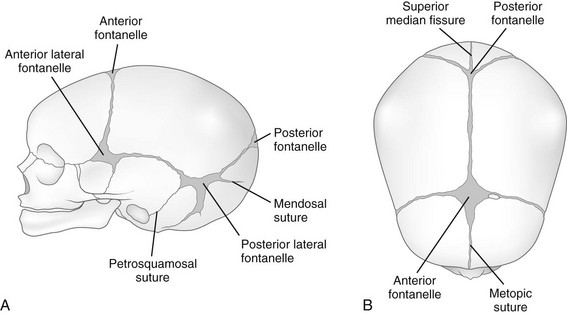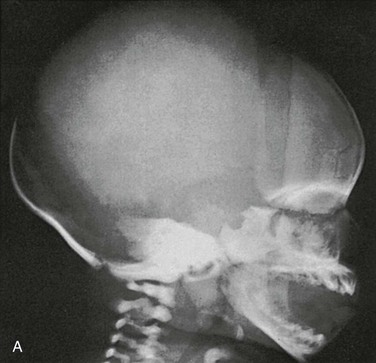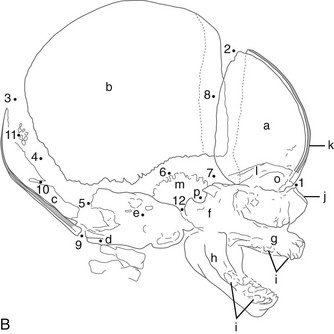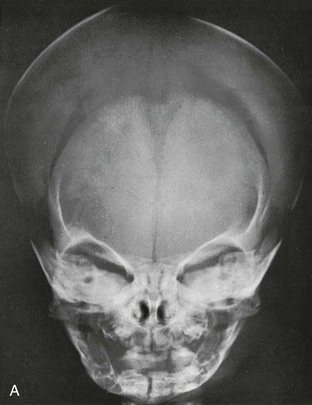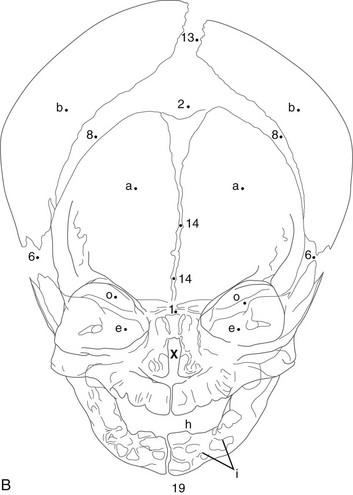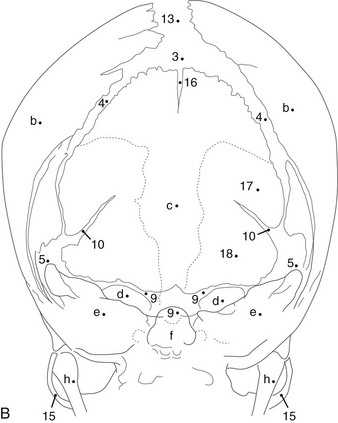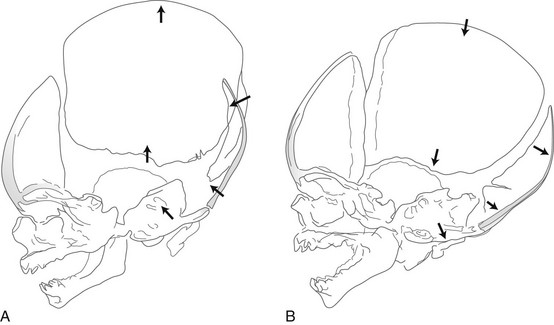Embryology, Anatomy, Normal Findings, and Imaging Techniques*
Anatomy of the Skull
Indications for plain film skull examination are listed in Box 18-1. Computed tomography (CT) and magnetic resonance imaging (MRI) generally are used for detailed evaluation of facial structures and intracranial contents.
Neonatal and Infant Skull
During infancy the neurocranium is larger relative to the face than at any other time during normal growth. Ratios of the respective areas of the neurocranium in lateral projection are roughly 3 : 1 to 4 : 1 at birth, and they decrease to 2 : 1 to 2.5 : 1 by age 6 years. The bones of the calvarium lie in their incompletely mineralized membranous capsule; they are separated by broad strips of connective tissue that form the sutures and by patches of connective tissue, the fontanelles. The six constant, or major, fontanelles are located at the four corners of the parietal bones—two in the midline of the skull and two pairs on each side (Fig. 18-1). Accessory fontanelles may occur in several parts of the cranium but usually are located in the sagittal suture. The sutures and the synchondroses in the base are prominent in newborns but diminish in width during the first 2 to 3 months. Obliteration of the sutures does not begin until the second to third decades. Figures 18-1 through 18-4 and e-Figure 18-5 illustrate sutures, fontanelles, and synchondroses.

e-Figure 18-5 Occipital bone at birth, internal surface.
The sphenoid bone at birth consists of a single central mass composed of the body and the lesser wings and two symmetric lateral osseous masses, each of which is made up of a greater wing and a pterygoid process. The pituitary fossa in the body of the sphenoid bone tends to be round with smooth margins; the dorsum sella is short and blunt, and the clinoid processes are rudimentary. The angle between the body of the neonatal mandible and the ascending ramus in lateral projection is about 160 degrees; the relatively large bodies are separated in the midline by a prominent cartilaginous symphysis mentalis (see Fig. 18-3). Early calcification of teeth is seen in the fifth fetal month.1
Components of the individual bones that are not united in infancy may lead to confusion unless they are correctly recognized. The frontal bone is divided in half laterally by the metopic suture (see Figs. 18-1 and 18-3). Apparent discontinuity of the sphenoid bone with the frontal bone superiorly and the occipital bone posteriorly indicates the sites of the sphenoid bone’s synchondroses with these two bones (see Fig. 18-2). The four major components of the occipital bone (e-Fig. 18-5 and Fig. 18-2) likewise may simulate discontinuities of structure.
Growth and Development
With increasing age, the fontanelles and sutures become smaller and narrower. The anterior fontanelle usually is reduced to fingertip size during the first half of the second year; the posterior fontanelle may be closed at birth (range of closure: birth to several months). Closure of the fontanelles occurs clinically before it is seen radiographically. The metopic suture is quite variable and may be obliterated at birth, but it usually is closed during the third year; however, it persists throughout life in about 10% of cases. In the occipital bone, the mendosal suture (see Fig. 18-4 and e-Fig. 18-5) usually disappears during the first 2 years, but it too can persist; the synchondrosis between the supraoccipital and exoccipital (supracondylar) portions usually disappears during the second or third year. The spheno-occipital synchondrosis begins to close near the time of puberty but may persist until the twentieth year. This variation and irregularity make suture lines unreliable criteria for estimation of the developmental age of the skull. At about the twentieth year, the skull attains its definitive size.
Normal Variations
Intrasutural, or wormian, bones occur most frequently along the lambdoid sutures (Fig. 18-6 and e-Fig. 18-7; Box 18-2). They occur much less frequently in the fontanelles (see e-Fig. 18-7). The interparietal or Inca bone (Fig. 18-8) results from division of the supraoccipital portion of the occipital bone into two parts by the mendosal suture, with the superior part arising from membranous bone and the inferior part arising from cartilage continuous with that of the supracondylar portions and the basiocciput. A rare synchondrosis or suture line runs vertically through the squamous portion of the occipital bone (Fig. 18-9); persisting superior and inferior portions of the line are known as the superior longitudinal fissure or bi-interparietal suture and the cerebellar synchondrosis or median cerebellar suture. Where the supraoccipital portion of the occipital bone forms the posterior border of the foramen magnum, accessory supraoccipital bones occasionally are found (e-Fig. 18-10). The configuration caused by an outward bulge of the occipital squamosa just above the torcular Herophili in a newborn (Fig. 18-11) is called bathrocephaly. Rarely, a horizontal interparietal suture divides the parietal bones into superior and inferior moieties (e-Fig. 18-12).
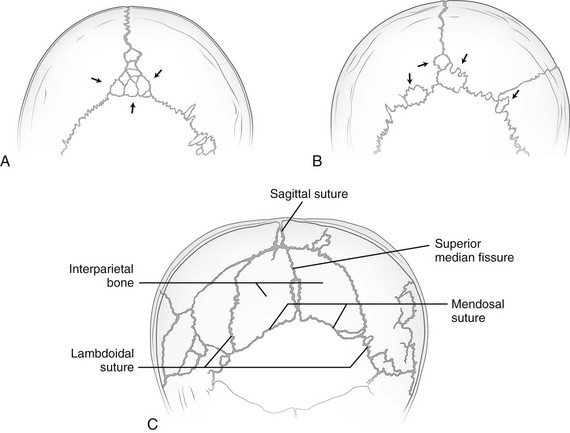
Figure 18-6 Tracings of films showing wormian bones.
A, Multiple wormian bones (arrows) in the sagittal suture. B, Multiple wormian bones (arrows) in the sagittal and lambdoid sutures. C, Interparietal bone bounded by the lambdoid and persistent mendosal sutures. The superior median fissure also is still present and divides the interparietal bone into right and left halves.

Figure 18-8 Interparietal (Inca) bone.
A, Lateral projection. B, Anteroposterior Towne projection. 1, Right and left lambdoid sutures; 2, mendosal suture; 3, accessory suture in interparietal bone. (Courtesy Dr. J.P. Dorst, Baltimore, MD.)

Figure 18-9 Occipital bone.
A, A Towne projection showing radiolucent midline longitudinal or cerebellar synchondrosis (arrows) in the occipital squamosa of an 11-year-old girl, which resulted from failure of fusion mediad of its lateral paired ossification centers. This radiolucent strip can be mistaken for a fracture line. (Sutures were retouched with a pencil.) B, Persistent longitudinal or cerebellar synchondrosis (d) in the occipital squamosa of a skull of a newborn; only the caudal segment of the synchondrosis is still open in this case. a, superior median longitudinal fissure; b, superior lateral longitudinal fissure; c, mendosal suture; e, synchrondrosis between exoccipital and supraoccipital bones; f, synchrondrosis between basioccipital and exoccipital bones. (From Koehler A, Zimmer EA. Borderlands of the normal and early pathologic in skeletal roentgenology. 3rd ed. Philadelphia: Grune & Stratton [translated from German ed 11 by S.P. Wilk]; 1968.)
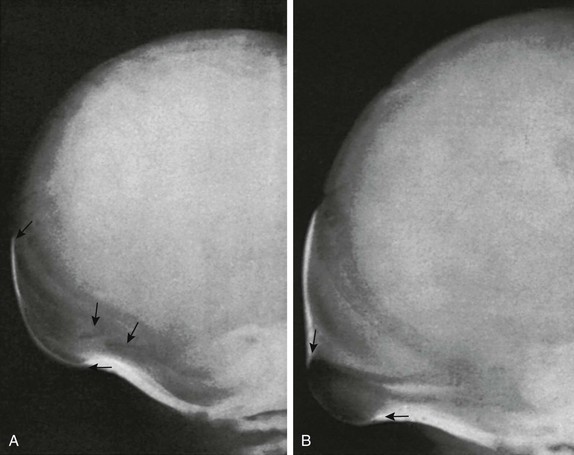
Figure 18-11 Bathrocephaly in a newborn.
A, The external bulge (arrows) extends from the lambda downward to the level of the mendosal suture of a normal 3-day-old infant. B, The bulge (arrows) in this normal 5-day-old infant begins below the mendosal suture.
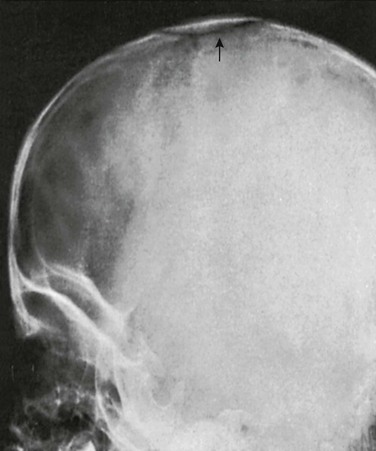
e-Figure 18-7 A large independent bone (arrow) in the membrane of the anterior fontanelle of a normal  -year-old girl.
-year-old girl.
Normal variants of this type must be kept in mind when evaluating films made after trauma. (Courtesy Dr. B.R. Girdany, Pittsburgh, PA.)
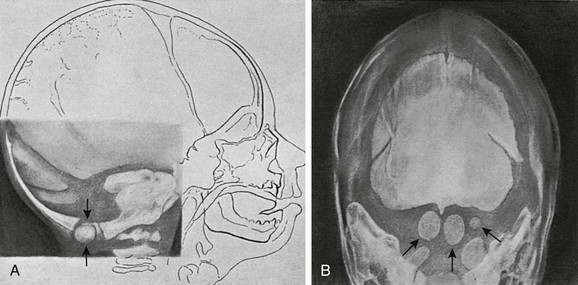
e-Figure 18-10 Accessory bones of the supraoccipital bone.
A, Lateral projection on the second day of life shows separate bony images (arrows) in the innominate synchondrosis. B, A Towne projection of the same skull on the 20th day of life. Three ossicles (arrows) are present in the cartilage above the foramen magnum, along with a midline bony process on the under edge of the supraoccipital that is similar to the fetal process in this same site described by Kerckring in Spicilegium Anatomicum (Amsterdam, 1670).

e-Figure 18-12 Bilateral bifid parietal bones, each of which is divided into an upper and lower segment by an extra horizontal suture.
The flattening of the occipital squamosa is postural in origin. The infant was 6 months old and had not experienced a head injury. Lateral (A) and frontal (B) projections are shown. Upper arrows point to the anomalous horizontal intraparietal sutures, and lower arrows point to the normal squamosal (parietotemporal) sutures. (Courtesy Dr. B.R. Girdany, Pittsburgh, PA.)
Compression of the fetal skull and its molding during passage through the maternal pelvis produce significant radiographic findings that persist after birth (Fig. 18-13).2 During the first weeks and months of life, widths of sutures vary so much that caution is required in their evaluation for the diagnosis of increased intracranial pressure, particularly because positioning is difficult and partial superimposition of bilateral sutures can produce spurious widening (Fig. 18-14).
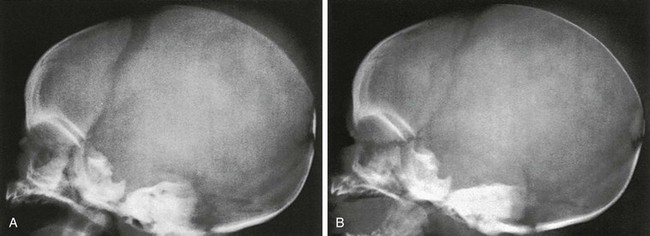
Figure 18-14 Factitious widening of the coronal suture.
A, A slightly oblique projection in which the right and left limbs of the coronal suture overlap. B, A projection that is a little more oblique than A in which the individual, narrower, right and left limbs are seen.
In children older than 2 years, the sutures extend through both tables and the diploic space. The outer table portion of the suture may be deeply serrated when the inner table portion is practically a straight line (e-Fig. 18-15) and may be interpreted erroneously as a “fracture through a suture.” Persistence of the metopic suture may simulate a vertical fracture in the occipital bone in anteroposterior, caudally angulated exposures if extension of the superimposed radiolucent line into the area of the foramen magnum is invisible or if the inferior portion of the suture has been obliterated. The frontal crest on the internal surface of the frontal squamosa in the midsagittal plane may be sufficiently prominent to simulate calcification of the falx cerebri that attaches to it (e-Fig. 18-16).
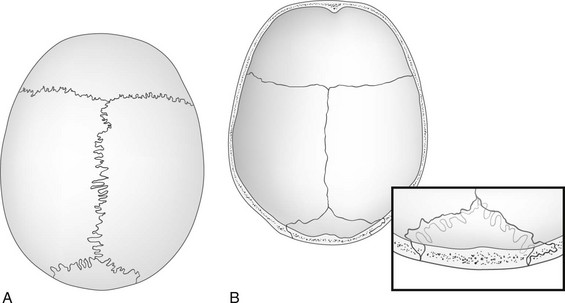
e-Figure 18-15 Drawings of anatomic specimens show the relationship of the outer and inner tables and diploic space of the calvaria to the great sutures.
A, The external aspect of the calvaria shows deep serrations in sutures of the outer table. B, The internal aspect shows the straight, nonserrated sutures of the inner table. The inset drawing depicts the lambdoid suture near the lambda; the differences in position and course of the sutures of the outer and inner tables are shown. In the diploic space, the suture runs in a plane at approximately right angles to the course of the sutures in the tables.
Juvenile Skull
After a child is 2 years old, the radiographic appearance of the skull is similar in most respects to that of the skull during adult life (Fig. 18-17). With advancing age, the skull gradually grows and differentiates until late in childhood, when all of the essential characteristics of the adult skull have developed (Figs. 18-18 through 18-20).

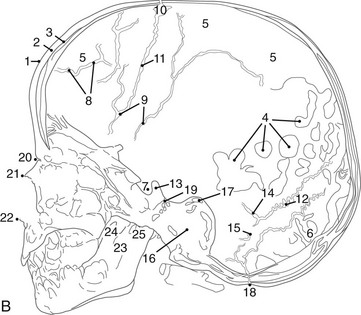
Figure 18-17 A radiograph of the normal skull at 2 years.
A,

